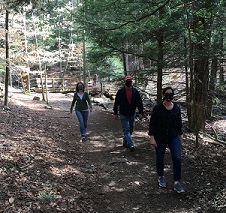A Global Pandemic
Introduction Letter Summary The Climate Challenge
The Status of Connecticut’s Environment During a Global Pandemic
While the 2019 novel coronavirus (COVID-19) emergency is not what we usually think of as an environmental issue, the viral outbreak provides an interesting lens through which to examine the data presented in this report. The virus rapidly spread globally highlighting the interrelation and cross-boundary communion of environmental conditions. There are no borders which insulate us from human actions and impacts. The differing effectiveness of each country’s measures taken to control the virus instruct us that borderless problems require coordinated solutions. The virus recognizes no social, economic, racial or national lines. Likewise, air pollution, water pollution and climate change respect no political borders.
The virus imposed some practical challenges to the monitoring of environmental conditions and enforcement of environmental regulations. Data for some indicators were affected by measures to reduce exposure of State employees to COVID-19 and by residents’ personal behaviors in response to the virus. Specifically, there were fewer inspections by employees of the Connecticut Department of Energy and Environmental Protection (DEEP), as detailed in the  Compliance page; and there were no marine survey tows in Long Island Sound this year, as detailed in the Lobster and Fishes of Long Island Sound page.
Compliance page; and there were no marine survey tows in Long Island Sound this year, as detailed in the Lobster and Fishes of Long Island Sound page.
In addition, several of the indicators increased or decreased, more than would be normally expected, due to the response to the COVID 19 virus. For example, residential electricity consumption increased significantly in 2020, in part, because people were spending more time at home, while bus ridership and bottle redemption declined in 2020.
The safety measures put in place to reduce the transmission of the COVID 19 virus resulted in a renewed appreciation for Connecticut’s natural spaces. According to the Connecticut Trail Census, it is estimated that approximately 2.57 million residents visited trails throughout the State on 2020; an increase from 1.54 million users in 2019.A As another example, attendance at Rocky Neck State Park increased almost 100 percent from 7,774 vehicles in 2019 to 15,024 vehicles in 2020, for the period mid-March to mid-April. In addition, DEEP’s Environmental Conservation Officers saw a nearly 300 percent increase in “calls for service” in the State’s parks in 2020.1 Connecticut’s “Passport to the Parks” program, which was authorized in 2017, allows any State resident, by paying a $5 fee per year for each registered non-commercial vehicle, access to any of Connecticut’s 139 State’s parks, in addition to forests, trails, and beaches.
—————
A The Connecticut Trail Census is a statewide volunteer data collection program to inform a better understanding of multi-use trail use and to share data with trail groups, trail administrators, government agencies and the public. Funded by the Connecticut DEEP Recreational Trails Program.
1 Connecticut Department of Energy and Environmental Protection (DEEP); personal communication from T. Tyler, March 24, 2021.


